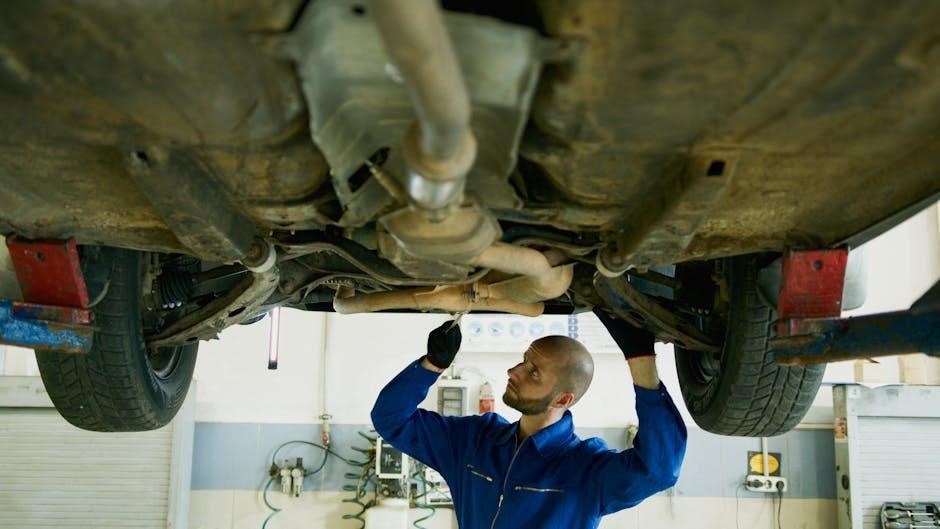Transmission types include automatic and manual, each with unique features and benefits, allowing drivers to choose between convenience and control, with various factors influencing their decision, including personal preference and driving habits always.
Overview of Automatic and Manual Transmissions
Automatic and manual transmissions are the two primary types of transmissions used in vehicles, each with its own unique characteristics and advantages.
The main difference between the two lies in the way the gears are shifted, with manual transmissions requiring the driver to manually shift gears using the clutch pedal and gear stick, while automatic transmissions automatically shift gears without driver input.
Understanding the basics of both transmission types is essential for drivers to make informed decisions when choosing a vehicle, and to appreciate the benefits and drawbacks of each type, including factors such as fuel efficiency, performance, and driving experience, which can vary significantly between automatic and manual transmissions, and depend on various factors, including driving habits and road conditions, and the type of vehicle being driven.

Understanding Manual Transmissions
Manual transmissions require driver engagement, using clutch and gear stick, providing control and connection to the vehicle, with a unique driving experience, and specific maintenance needs always required.
Role of the Driver in Manual Transmissions
The driver plays a crucial role in manual transmissions, as they are responsible for shifting gears using the clutch pedal and gear stick. This requires a level of skill and coordination, as the driver must press the clutch pedal, shift into the desired gear, and then release the clutch pedal while giving the vehicle gas. The driver’s ability to properly shift gears and use the clutch can greatly affect the performance and efficiency of the vehicle. A skilled driver can optimize fuel efficiency, improve acceleration, and reduce wear on the transmission. In contrast, a driver who is new to manual transmissions may experience difficulty shifting gears, which can lead to stalling the vehicle or wearing down the clutch. As a result, the driver’s role in manual transmissions is an important factor to consider when deciding between a manual and automatic vehicle. The driver’s level of experience and comfort with manual transmissions can greatly impact their overall driving experience.
Components of Manual Transmissions
Manual transmissions consist of several key components, including the clutch, gear stick, and transmission shaft. The clutch is a friction plate that connects and disconnects the engine from the transmission, allowing the driver to shift gears. The gear stick, also known as the shift lever, is used to select the desired gear, while the transmission shaft transmits power from the engine to the wheels. Other components, such as the flywheel, pressure plate, and bearings, also play important roles in the operation of a manual transmission. The simplicity of manual transmissions, with fewer parts than automatic transmissions, can make them more reliable and easier to maintain. The components of a manual transmission work together to provide a smooth and efficient driving experience, allowing the driver to have control over the vehicle’s gear shifts and acceleration. The design and construction of these components can vary depending on the vehicle manufacturer and model.

Understanding Automatic Transmissions
Automatic transmissions offer a smooth and convenient driving experience, with the car shifting gears automatically, using complex systems and sensors to optimize performance and efficiency always and perfectly.
How Automatic Transmissions Work
Automatic transmissions use a complex system of sensors, gears, and hydraulic controls to automatically shift gears, providing a smooth and convenient driving experience. The transmission uses a torque converter to connect and disconnect the engine from the transmission, allowing the car to shift gears seamlessly. A system of planetary gears and clutches works together to provide the optimal gear ratio for the current driving conditions. The transmission controller uses data from various sensors, including speed and acceleration sensors, to determine when to shift gears. This process happens quickly and smoothly, allowing the driver to focus on the road. The automatic transmission also includes a number of safety features, such as a neutral gear and a parking pawl, to prevent the car from moving unexpectedly. Overall, the automatic transmission is a sophisticated system that provides a convenient and comfortable driving experience. The technology behind automatic transmissions continues to evolve and improve.
Key Differences Between Manual and Automatic
The main difference between manual and automatic transmissions is the level of driver involvement. Manual transmissions require the driver to manually shift gears using the clutch pedal and gearshift, while automatic transmissions automatically shift gears. This difference affects the driving experience, with manual transmissions providing more control and engagement, and automatic transmissions offering more convenience and ease of use. The presence of a clutch pedal in manual transmissions is a notable distinction, as it allows drivers to disconnect the engine from the transmission and shift gears manually. In contrast, automatic transmissions use a torque converter to connect and disconnect the engine from the transmission. These differences impact the overall performance, fuel efficiency, and maintenance requirements of the vehicle. Additionally, the driving style and habits of the driver can also influence the choice between manual and automatic transmissions. The differences between manual and automatic transmissions are significant.

Reliability and Maintenance
Transmission reliability and maintenance requirements vary, with factors like driver behavior and vehicle condition affecting durability and performance always needing consideration and regular checks.
Comparing Reliability of Manual and Automatic Transmissions
Comparing the reliability of manual and automatic transmissions is a complex task, as it depends on various factors, including driver behavior, vehicle condition, and maintenance habits. Manual transmissions are generally considered to be more reliable due to their simpler design and fewer components; However, with the advancement of technology, automatic transmissions have become more reliable and efficient. A study found that manual transmissions have a lower failure rate compared to automatic transmissions, but this can be attributed to the driver’s ability to control the transmission. On the other hand, automatic transmissions are more prone to wear and tear, especially in stop-and-go traffic. Regular maintenance, such as fluid changes and filter replacements, can help extend the lifespan of both manual and automatic transmissions. By considering these factors, drivers can make informed decisions about the reliability of their transmission type. Overall, both manual and automatic transmissions have their own strengths and weaknesses.

Driving Experience and Control
Manual transmissions offer more control, while automatics provide a smoother experience, with drivers preferring one over the other based on personal preference and driving style always matters in this decision process.
Engagement and Convenience in Manual and Automatic Cars
Manual transmissions offer a more engaging driving experience, requiring the driver to shift gears and use the clutch, which can be enjoyable for some, while others may find it tiresome.
On the other hand, automatic transmissions provide a more convenient driving experience, as the car shifts gears automatically, allowing the driver to focus on the road and other tasks.
According to various sources, the choice between manual and automatic transmissions ultimately depends on personal preference, driving habits, and the intended use of the vehicle, with some drivers preferring the control and engagement of manual transmissions, while others prefer the convenience and ease of automatic transmissions, and this difference in preference is what drives the debate between manual and automatic transmissions, with each side having its own unique benefits and drawbacks, and drivers must consider these factors when deciding which type of transmission is best for them, and make an informed decision based on their individual needs and preferences, and the type of driving they will be doing.
on Transmission Types
Ultimately, the choice between automatic and manual transmissions depends on a variety of factors, including personal preference, driving habits, and the intended use of the vehicle.
By considering these factors and weighing the pros and cons of each type of transmission, drivers can make an informed decision and choose the transmission that best suits their needs and preferences, and this decision can have a significant impact on their overall driving experience, and it is essential to carefully consider the options and choose the transmission that is right for them, and in doing so, they can enjoy a safe and enjoyable driving experience, with the knowledge that they have made the best choice for their individual circumstances, and this is the key to a successful and satisfying driving experience.
